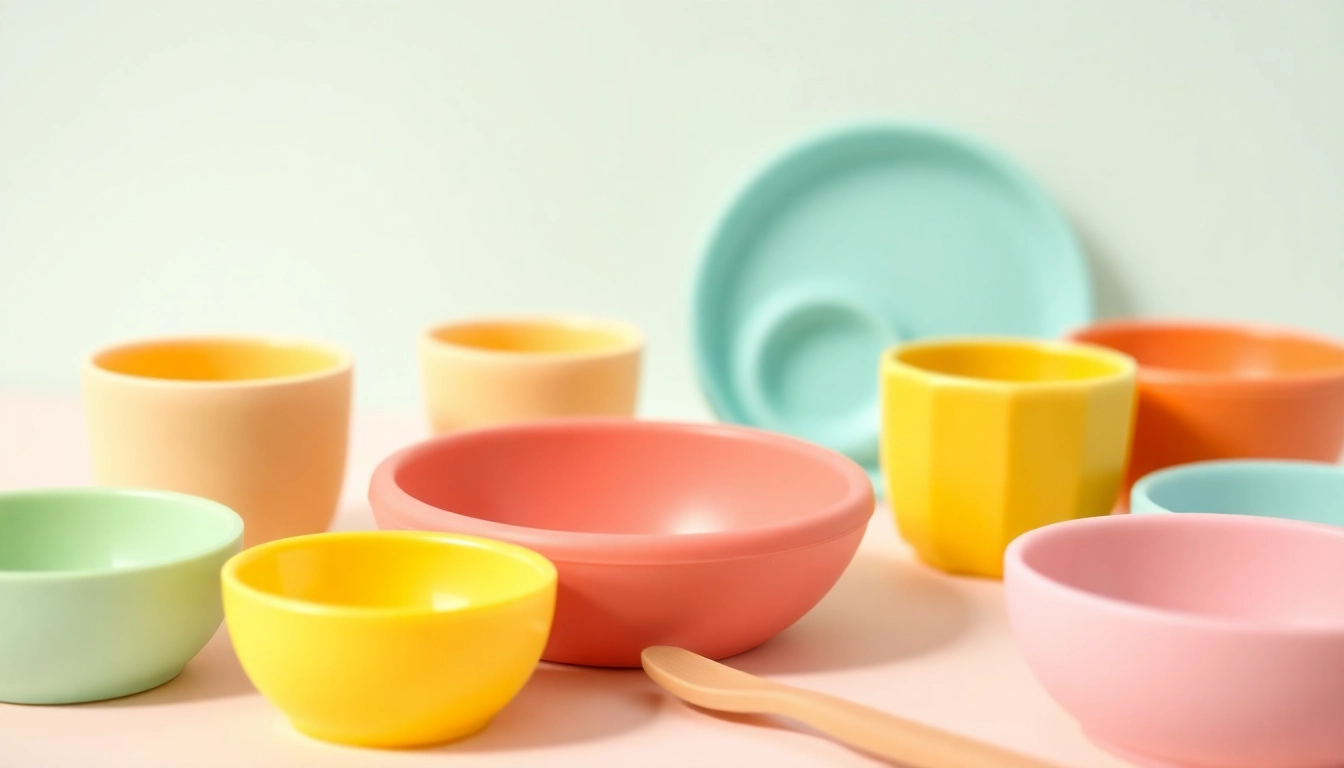Understanding the Importance of Safe Silicone Baby Tableware
Providing infants and toddlers with food-safe and reliable tableware is essential for promoting healthy eating habits and ensuring their safety. Among various materials used for baby dishes, silicone has emerged as a preferred choice due to its non-toxic, durable, and versatile nature. When selecting Safe silicone baby tableware, parents must prioritize safety features, quality certifications, and design aspects to create a positive mealtime experience that fosters development and independence.
Why Safety Features Matter in Baby Tableware
Safety is the cornerstone of any baby product, especially tableware, which directly interfaces with a child’s health and well-being. Features such as BPA-free materials, absence of phthalates, lead, and other harmful substances are non-negotiable. Safe silicone tableware is designed to be free from toxins, ensuring that children are not exposed to endocrine disruptors or carcinogens during their formative years. Additionally, stability features like non-slip bases and vented lids help prevent accidents, while smooth edges and ergonomic shapes minimize injury risks during handling and feeding.
Benefits of Silicone Compared to Other Materials
Silicone offers numerous advantages over traditional plastics,玻璃, or melamine. Its flexibility and resilience make it resistant to cracks and breaking, a common concern with glass and ceramic dishes. Silicone is naturally non-stick, simplifying cleaning and reducing the need for harsh detergents. Moreover, it withstands high temperatures, making it suitable for microwave and oven use without deformation or chemical leaching. Its FDA approval as a food-grade material assures parents of its safety standards. Additionally, silicone’s inert nature means it does not absorb odors or stains, maintaining a fresh look over time.
Certifications and Quality Indicators to Look For
Reputable brands focusing on baby tableware adhere to strict quality standards and obtain certifications such as FDA approval, LFGB certification, or EU food safety standards. These indicators verify that the silicone material has been rigorously tested for safety and purity. When purchasing, look for products explicitly labeled as BPA-free, phthalate-free, and free from other toxic chemicals. Quality indicators include smooth, seamless manufacturing to prevent bacterial buildup, and durable construction that withstands repeated cleaning and sterilization. Authentic certifications also often come with detailed documentation and traceability, ensuring traceability to Italian or European manufacturing standards renowned for their safety.
Key Factors When Selecting Safe Silicone Baby Tableware
Design and Ergonomics for Easy Use
Design plays a vital role in facilitating independent eating and safe handling. Products such as the SoftEdge Plate exemplify ergonomic design with smooth, rounded edges that prevent injuries. Features like raised rims guide food onto utensils and minimize spills. Handles or grips on bowls and plates aid children in gripping and managing their dishes, supporting motor development and confidence at the table. A thoughtful design also considers the height and weight of utensils and dishes, making them manageable and comfortable for small hands.
Durability and Ease of Cleaning
Durability ensures that silicone tableware can withstand daily use, hot washes, and sterilization without degrading. High-quality silicone resists tearing, cracking, or warping, preserving safety and appearance. Ease of cleaning is equally important; dishwasher-safe options or products that can be easily rinsed promote hygienic practices. Non-porous surfaces prevent bacteria and mold buildup, maintaining a healthy eating environment. Selecting items with minimal seams and smooth surfaces further simplifies cleaning routines, reducing the risk of residual contamination.
Size, Shape, and Functionality for Growing Babies
Adapting to a child’s growth and developmental milestones requires thoughtful sizing and versatility. Smaller bowls and plates are suitable for initial feeding phases, while larger, multi-compartment dishes support varied diets and portion control. Shapes like the Puppy Plate with removable compartments or the Rainbow Plate serve visual appeal and practicality, encouraging self-feeding. Functional features such as suction bases prevent slipping, enabling even the youngest children to develop greater autonomy during mealtime.
Best Practices for Using and Maintaining Silicone Baby Tableware
Proper Cleaning and Sanitization Tips
Maintaining hygiene is critical for infant feeding accessories. Silicone tableware can be sterilized by boiling, steam sterilization, or dishwasher cleaning, provided it is dishwasher-safe. Regularly inspect for any signs of wear or damage and replace items as necessary. Gentle, child-safe detergents are recommended to preserve material integrity. Avoid abrasive scrubbers that may scratch surfaces, creating niches for bacteria. Ensuring thorough drying prevents mold and bacterial growth, maintaining safe conditions for regular use.
Safe Usage During Transition Phases
As children transition from purees to solid foods, choosing adaptable tableware that supports varying textures and portions is essential. Silicone utensils with ergonomic handles assist in developing fine motor skills, while bowls with suction bases provide stability during self-feeding. Monitoring the child’s interaction with the tableware allows caregivers to prevent choking hazards and accidental ingestion of small parts. Gradually introducing new shapes and features encourages independence and confidence at the table.
Storage and Handling to Preserve Material Integrity
Proper storage minimizes wear and preserves the safety standards of silicone tableware. Store items in a cool, dry place away from direct sunlight and sharp objects. Avoid stacking heavy objects on top to prevent deformation. When not in use, ensure the silicone dishes are clean and completely dry to prevent mold formation. If necessary, store in a designated container or drawer that prevents damage, ensuring longevity and continued safety for your child’s use.
Top Brands and Features That Guarantee Safety
Comparative Review of Leading Brands
Leading brands like Bèbeboom prioritize safety, design, and quality certifications. Their products are made in Italy with strict adherence to safety standards such as LFGB and FDA approval. These brands often incorporate innovative features like soft, ergonomic edges, suction bases, and multi-compartment designs tailored for early self-feeding and developmental needs. Customer reviews consistently highlight durability, ease of cleaning, and child-friendly aesthetics, setting them apart from less reputable options.
How to Identify Genuine Certifications and Quality Marks
Authentic certifications are usually marked on the product or packaging, accompanied by official logos and documentation. Look for seals such as LFGB, USDA, or European food safety marks. Verify the certification numbers and ensure they correspond with reputable issuing agencies. Purchase from trusted retailers or directly from manufacturers to minimize the risk of counterfeit products. Transparent brands provide detailed safety information, including sourcing, manufacturing practices, and testing results.
Customer Reviews and Practical Usage Examples
Parents frequently praise silicone tableware for its durability during travel, ease of cleaning, and child-friendly design. Testimonials often mention how suction bases keep plates firmly in place, reducing messes, while ergonomic utensils facilitate self-feeding. Many commend the visual appeal, specific to vibrant shapes like rainbows or animal themes, which motivate children during mealtime. Such real-world usage examples are invaluable when assessing a product’s safety and practicality.
Innovative Trends and Future Developments in Baby Tableware
New Materials and Eco-friendly Innovations
Industry advancements focus on sustainable, eco-friendly materials that minimize environmental impact. Biodegradable, plant-based silicones or recycled composites are emerging as alternatives, reducing reliance on virgin plastics. Innovations also include antimicrobial coatings to prevent bacterial growth, and biodegradable packaging, aligning with eco-conscious consumer trends. These developments aim to balance safety, functionality, and environmental responsibility.
Smart Features and Interactive Designs
The future of baby tableware incorporates smart technologies such as temperature indicators, portion control sensors, or interactive features that engage children and promote learning. For example, plates with built-in sound or light cues can encourage independence, while apps linked to utensils might monitor eating habits. Such innovations aim to enhance developmental benefits and create engaging mealtime routines.
Guidelines for Staying Updated on Safety Standards
With evolving safety regulations, parents and caregivers should stay informed through reputable sources such as official standards organizations, pediatric associations, and brands committed to transparency. Subscribing to industry newsletters, attending parenting workshops, and following trusted brand updates can help incorporate the latest safety innovations. Additionally, verifying product certifications regularly ensures ongoing protection as standards evolve.



